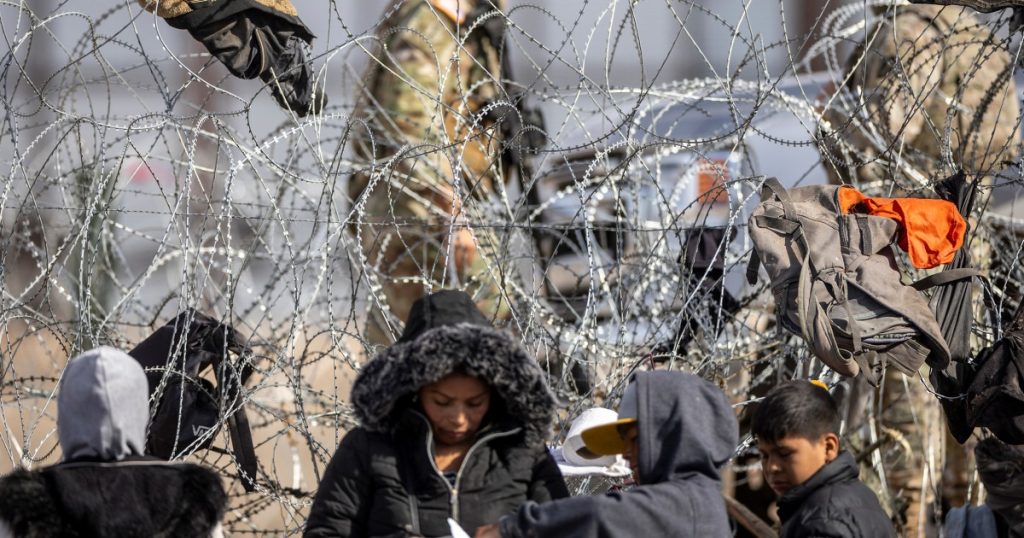
WASHINGTON — Former President Donald Trump, House Speaker Mike Johnson and other right-wing Republicans say they oppose an emerging bipartisan immigration deal because it would allow 5,000 migrants to illegally cross the southern border each day.
“It is illegal to cross our border. But apparently, we’re concocting some sort of deal to allow the president to shut down the border after 5,000 people break the law,” Johnson, R-La., said Wednesday. “Why is it 5,000? If you add that up, that’d be a million more illegals into our country every year before we take remedial measures. It’s madness. We shouldn’t be asking what kind of enforcement authority kicks in at 5,000 illegal crossings a day, because that the number should be zero.”
Trump made a similar claim to reporters Tuesday: “That’s a terrible bill. 5,000 a day? That’s a lot. That’s like record-setting stuff.”
But that’s not actually what the bipartisan deal would do, according to negotiators who are finalizing the details before releasing the full text of the legislation, potentially later this week. Here’s what we know:
Migrants would not just be released into the U.S.
Migrants would not be able to just cross the border illegally under the new bill. It would end the practice of “catch and release,” in which Border Patrol agents release migrants into the U.S. while they await immigration hearings.
Instead, migrants who attempt to cross the border illegally would be detained immediately with their asylum claim decided while they are in detention. Individuals would be removed immediately within 15 days if they fail their asylum claim interview.
What about migrants who try to cross legally with asylum claims?
If the deal becomes law, migrants who come to the U.S. border at an official port of entry would be diverted to a new “removal authority program” in which they will have 90 days to make their initial asylum interview. Those migrants would not be released into the interior of the U.S. either; they would either be detained or kept under government supervision.
If they fail their initial asylum interview, they would be immediately removed.
But migrants who pass the asylum interview would get to stay in the country for an additional 90 days until their asylum cases are decided. In the meantime, they would receive a work authorization. Once their cases are adjudicated, they would qualify for a path to citizenship.
So where did this 5,000-a-day figure come from?
The bipartisan deal does include provisions that would shut down the border entirely if a certain threshold is hit, but those are border encounters, not crossings. As noted above, no migrant trying to enter the U.S. illegally would be allowed into the country unless they passed an asylum interview or were being held under government supervision.
In addition to those provisions, the Department of Homeland Security could close the border if too many migrants are showing up with asylum claims. After negotiators conferred with the border patrol and officials at the Department of Homeland Security, they crafted the legislation to give DHS the authority to close the border if they reach a seven-day average of 4,000 or more border encounters. A seven-day average of 5,000 or more would mandate a border closure. If the number exceeds 8,500 in a single day, there would also be a mandatory border closure.
What happens if the border is closed?
If the border is shut down, up to 1,400 migrants per day who try to enter at official ports of entry would still qualify to have their asylum claims considered. The rest would be turned away.
Migrants encountered in between ports of entry would be immediately turned away. If the same person tries to cross twice when the border is shut down in between ports of entry, they would be barred from entering the U.S. for one year.
To reopen the border, crossings would need to slow to below 75% of the number that triggered the border closure for seven days. DHS would then have up to two weeks to slowly reopen the border based on capacity.
There is a limit to how long the border can be shut down, to avoid abuse of the authority. For 2024, it is capped at 270 days, but the number is designed to fluctuate year by year as negotiators hope that migrant crossings will slow with the new law in place.
The bill is designed to discourage illegal crossings
Over time, negotiators believe that this legislation, and ending the practice of catch and release, will encourage migrants to seek asylum lawfully at ports of entry rather than attempting to cross illegally in between ports of entry.
The bill will also raise the standard for seeking asylum. And it will provide other resources for the border, including increasing detention capacity for migrants who are held pending asylum claims.
 Latest Breaking News Online News Portal
Latest Breaking News Online News Portal






